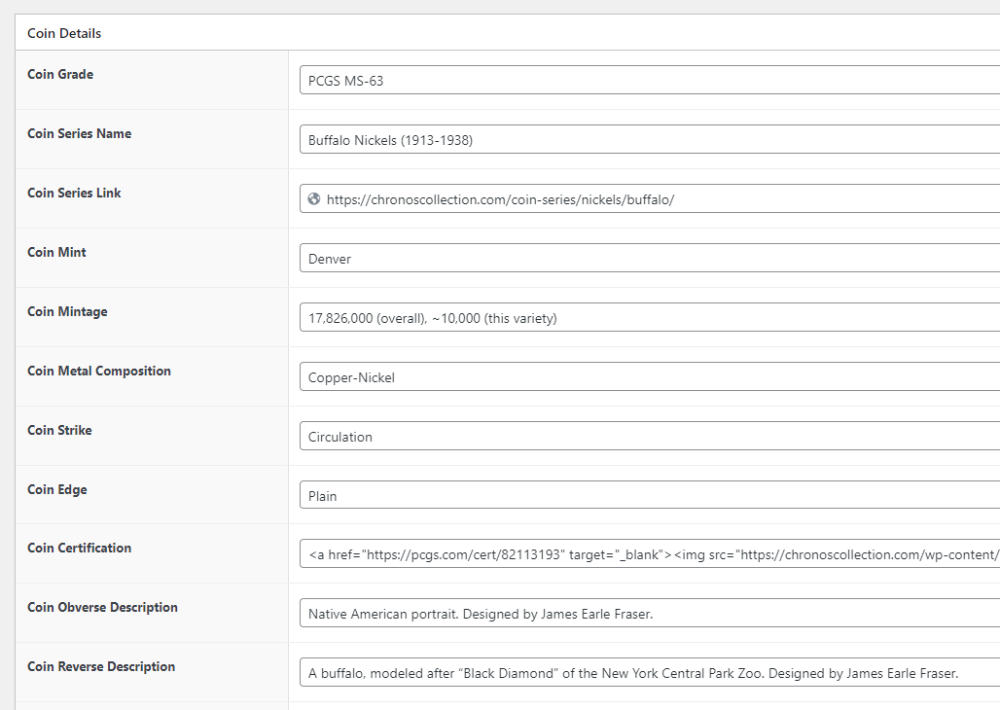Research and Design: What makes a good coin exhibit?
Before setting out to build an online exhibit for my personal coin collection, I did a lot of research. Several coin registries exist, and each allows you to display photos. But these systems are built by third parties and are very rigid in what they let you customize. So building my own from scratch was really the only option I considered.
Before anything else, I needed to get the design right. I wanted a modern clean look. I wanted the coin obverse and reverse to be front and center. And I wanted to figure out how to present a lot of technical information in an attractive, intuitive way.
My research took me to a lot of museum websites. Museums have large catalogs of some real treasures. They must present a lot of items and information easily to the general public. And they must allow for sorting and searching their vast archives.

Inspired by online museum collections from the likes of the MoMA, and the National Gallery of Art, I was able to handcraft a coin display page with which I was happy.
Design and Code: Simple and Flexible
After finishing the design, I needed to start coding. I settled on WordPress as my content management system. I’m familiar with it and it powers more than 40% of the entire internet. That means it should be around for many years. Future-proofing as much as possible is important to me.
I started coding my design, first for the desktop, and then for tablets and mobile devices. Again, we’re dealing with a lot of technical information on each page: coins series, design type, country of origin, finishes, strike details, mintage figures and mint locations, designers, third-party grades and any additional certifications or stickers. Not to mention the professional photographs and individual descriptions for each piece.
This information could get overwhelming, not only to display, but also to input on the backend. So I built a custom form that I can use when entering new coins.

This intuitive form allows me to input new coins quickly and (hopefully) error-free. Then the code I wrote takes the input from the form and dynamically builds each page of the coin exhibit as it’s requested by a visitor.

That sounds complex, and it is, but it’s all invisible to the viewer. They just see a great-looking coin page. But none of those pages exist on the backend. I just fill out the form for each new piece I acquire, and the code I wrote automatically builds each page.
Browsing and Sorting an Online Coin Exhibit
Unlike a physical collection, one of the main benefits to digital data is the myriad of ways in which it can be sorted, organized, and tagged. While my coin collection currently only consists of 97 pieces, I add to it regularly. In the future, it may grow to hundreds or thousands of coins. So setting up a strong and intelligent organizational scheme now at the beginning will pay dividends in the future.

All the sets, showcases, series, and other browse pages are built dynamically based on a few sets of keyword tags.

Using this hierarchical structure allows me to add endless coins to the collection and keep everything organized. With a couple clicks, you can view only Lincoln Memorial Cents, or all Lincoln Cents regardless of reverse design, or all Small Cents, or all U.S. Coins. You can dig as deep into a series as you’d like or take a wider view if you that’s what you prefer.
Future Looking
A huge benefit to having the data entered and stored using my unique form rather than building a page for each coin is that I could change the design sitewide at any point and never have to edit any individual page. Because each page is built “on the fly” when requested, keeping up with design standards and improvements should be easy. I could move the “Specifications” section of the page framework to another location and every coin page sitewide would follow.
As my collection grows, I hope this website grows with it. I’d like to expand the description on most of the coin pages to dig deeper into the history of each individual coin. I’d like to write articles about various coin series or short sets. And I’d like to connect with more collectors. This can be a solitary hobby most of the time.
Having a website now that can be flexible and grow with my collection feels great. I couldn’t be happier with how this project turned out.
I hope you enjoy your time here as much as I do!

